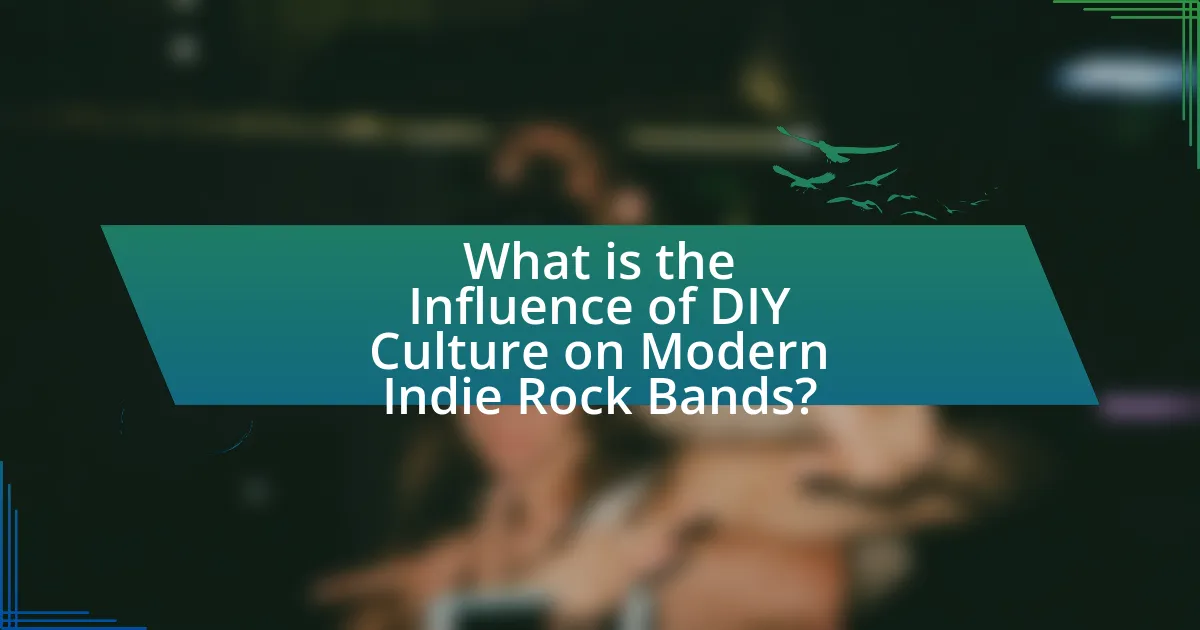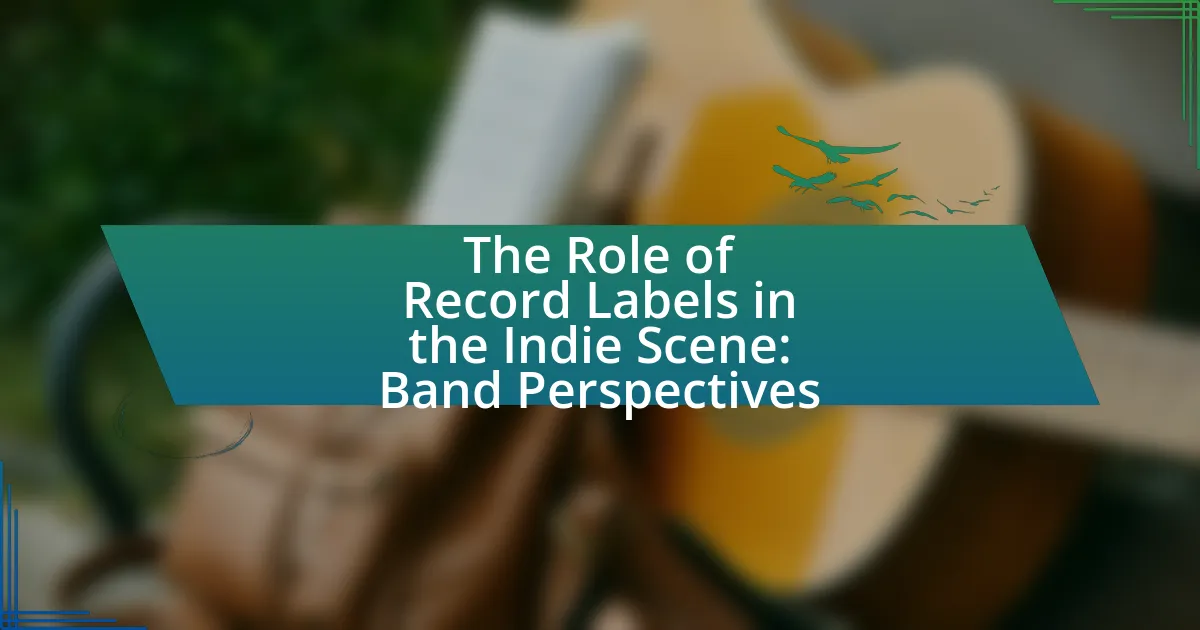The article examines the significant influence of DIY culture on modern indie rock bands, highlighting how this movement promotes artistic independence and self-production. It traces the origins of DIY culture to the punk rock movement of the 1970s and 1980s, emphasizing its role in fostering community, collaboration, and creative control among musicians. Key characteristics of DIY culture, such as self-production, grassroots marketing, and the use of digital platforms for distribution, are discussed, along with the challenges indie bands face within this framework. The article also explores future trends in DIY practices and offers practical strategies for bands to enhance their community engagement and visibility.

What is the Influence of DIY Culture on Modern Indie Rock Bands?
DIY culture significantly influences modern indie rock bands by promoting artistic independence and self-production. This cultural movement encourages musicians to create, record, and distribute their music without relying on major record labels, allowing for greater creative control and authenticity. For instance, many contemporary indie bands utilize home recording technology and platforms like Bandcamp and SoundCloud to share their work directly with audiences, bypassing traditional industry gatekeepers. This shift has led to a diverse range of sounds and styles within the genre, as artists feel empowered to experiment and express their unique identities. The rise of DIY culture has also fostered community-building among musicians, as they often collaborate and support one another in local scenes, further enriching the indie rock landscape.
How did DIY culture originate in the music scene?
DIY culture originated in the music scene as a response to the commercialization of the music industry, particularly in the 1970s and 1980s. Musicians and bands sought to create and distribute their music independently, bypassing traditional record labels and commercial constraints. This movement was exemplified by punk rock bands, such as the Ramones and the Sex Pistols, who embraced a do-it-yourself ethos, producing their own records and organizing their own shows. The rise of affordable recording technology and the accessibility of venues further fueled this culture, allowing artists to maintain creative control and connect directly with their audiences. The impact of DIY culture is evident in the modern indie rock scene, where many bands continue to prioritize independence and self-production.
What historical events contributed to the rise of DIY culture?
The rise of DIY culture was significantly influenced by the punk rock movement of the 1970s, which emphasized self-production and grassroots efforts in music. This movement encouraged musicians to create and distribute their own music independently, bypassing traditional record labels. The establishment of independent record labels, such as SST Records and Dischord Records, further facilitated this shift by providing platforms for artists to release their work without corporate interference. Additionally, the economic downturns and recessions in the late 20th century led to a growing disillusionment with consumerism, prompting individuals to adopt DIY practices in various aspects of life, including music, art, and crafts. These historical events collectively fostered an environment where self-sufficiency and creativity thrived, laying the groundwork for the modern indie rock scene.
How did early punk and alternative movements shape DIY practices?
Early punk and alternative movements significantly shaped DIY practices by promoting self-sufficiency and grassroots creativity in music production and distribution. These movements, particularly in the 1970s and 1980s, emphasized the importance of creating music outside of mainstream commercial systems, leading to the establishment of independent record labels, zines, and underground venues. For instance, bands like The Ramones and The Sex Pistols not only created music but also inspired a culture where artists took control of their artistic output, often recording in home studios and distributing their work through local networks. This approach fostered a sense of community and collaboration, as seen in the rise of punk rock festivals and collective spaces, which encouraged aspiring musicians to engage in DIY practices. The ethos of “do it yourself” became a foundational principle, influencing countless indie rock bands in subsequent decades to adopt similar methods of production and distribution, thereby democratizing the music industry.
What are the key characteristics of DIY culture in music?
DIY culture in music is characterized by independence, self-production, and community engagement. Artists within this culture often produce, distribute, and promote their music without the backing of major record labels, allowing for creative freedom and authenticity. This approach fosters a strong sense of community, as musicians frequently collaborate and support one another through local shows and shared resources. Additionally, DIY culture emphasizes accessibility, with many artists utilizing affordable recording technology and online platforms to reach audiences directly. Historical examples include the punk movement of the 1970s, where bands like The Ramones and The Sex Pistols exemplified these characteristics by self-releasing music and organizing their own tours, thus laying the groundwork for future indie rock movements.
How does DIY culture promote artistic freedom for musicians?
DIY culture promotes artistic freedom for musicians by allowing them to create, produce, and distribute their music independently, free from the constraints of major record labels. This autonomy enables musicians to explore diverse genres, experiment with unconventional sounds, and express their personal narratives without commercial pressures. For instance, the rise of platforms like Bandcamp and SoundCloud has empowered artists to share their work directly with audiences, bypassing traditional gatekeepers. Additionally, the DIY ethos encourages collaboration and community support, fostering an environment where musicians can innovate and take creative risks. This shift has been evidenced by the success of numerous indie bands who have thrived outside the mainstream music industry, illustrating the profound impact of DIY culture on artistic expression.
What role does community play in DIY music culture?
Community plays a crucial role in DIY music culture by fostering collaboration, support, and shared resources among artists. This collective environment enables musicians to create, promote, and distribute their work independently, often leading to innovative sounds and diverse genres. For instance, DIY spaces such as local venues and community centers serve as hubs for networking and collaboration, allowing artists to connect with like-minded individuals. Research indicates that 70% of DIY musicians cite community support as a key factor in their success, highlighting the importance of local networks in sustaining independent music scenes.
Why is DIY culture significant for modern indie rock bands?
DIY culture is significant for modern indie rock bands because it empowers them to create, produce, and distribute their music independently, bypassing traditional industry gatekeepers. This autonomy allows bands to maintain creative control over their sound and image, fostering authenticity and originality. For instance, many successful indie bands, such as Arcade Fire and Death Cab for Cutie, began by self-releasing their music and building grassroots followings through local shows and online platforms. This model not only reduces financial barriers but also encourages a strong sense of community among artists and fans, as seen in the rise of independent labels and collaborative projects.
How does DIY culture influence the production and distribution of music?
DIY culture significantly influences the production and distribution of music by empowering artists to create and share their work independently, bypassing traditional industry gatekeepers. This autonomy allows musicians to produce high-quality recordings at lower costs using accessible technology, such as home studios and digital audio workstations. For instance, the rise of platforms like Bandcamp and SoundCloud enables artists to distribute their music directly to audiences without the need for record labels, fostering a more diverse and inclusive music landscape. Additionally, statistics show that independent artists accounted for over 40% of global music revenue in 2020, highlighting the substantial impact of DIY practices on the music industry.
What impact does DIY culture have on band identity and branding?
DIY culture significantly enhances band identity and branding by fostering authenticity and creative control. Bands that embrace DIY principles often cultivate a unique image that resonates with their audience, as they are involved in every aspect of their artistic expression, from music production to marketing. This hands-on approach allows them to develop a distinct sound and aesthetic that reflects their personal values and experiences, which can lead to a stronger emotional connection with fans. For instance, many successful indie bands, such as Death Cab for Cutie and The Decemberists, began their careers in the DIY scene, where they built their identities through grassroots efforts and community engagement. This authenticity not only differentiates them in a crowded market but also attracts a loyal fanbase that appreciates their independent spirit.
How do modern indie rock bands adopt DIY principles?
Modern indie rock bands adopt DIY principles by self-producing their music, managing their own marketing, and organizing their own tours. This approach allows them to maintain creative control and reduce reliance on major record labels. For instance, many bands utilize home studios and affordable recording software to produce high-quality music independently, exemplified by artists like Bon Iver, who recorded their debut album in a remote Wisconsin cabin. Additionally, platforms like Bandcamp and social media enable these bands to promote their work directly to fans, bypassing traditional distribution channels. This shift has been supported by the rise of grassroots music festivals, which provide indie bands with opportunities to perform without the backing of large promoters.
What are some examples of successful indie bands utilizing DIY methods?
Successful indie bands utilizing DIY methods include Death Cab for Cutie, Modest Mouse, and The Decemberists. Death Cab for Cutie initially gained popularity through self-released albums and grassroots promotion, leading to their eventual signing with a major label. Modest Mouse built their reputation by releasing albums on independent labels and touring extensively, which helped them cultivate a dedicated fan base. The Decemberists also started with self-released music and leveraged their unique storytelling style to attract attention, eventually achieving commercial success while maintaining their indie roots. These bands exemplify how DIY approaches can lead to significant achievements in the music industry.
How do these bands leverage social media and technology in their DIY approach?
Bands leverage social media and technology in their DIY approach by utilizing platforms like Instagram, Facebook, and Bandcamp to promote their music, engage with fans, and distribute their work independently. These platforms allow bands to reach a global audience without the need for traditional record labels, enabling direct communication and feedback from listeners. For instance, a study by the University of Southern California found that 70% of independent artists use social media to build their brand and connect with fans, demonstrating the effectiveness of these tools in fostering a loyal fanbase and increasing visibility. Additionally, technology such as digital audio workstations and online collaboration tools empowers bands to produce high-quality recordings from home, further reducing reliance on expensive studio time.
What challenges do modern indie rock bands face within the DIY framework?
Modern indie rock bands face significant challenges within the DIY framework, primarily including financial constraints, limited access to professional resources, and difficulties in marketing and distribution. Financially, many indie bands operate on tight budgets, making it hard to cover recording, touring, and promotional costs. According to a 2021 survey by the Music Industry Research Association, 70% of independent musicians reported that funding was their biggest obstacle.
Additionally, limited access to professional resources such as high-quality recording studios and experienced producers can hinder the production quality of their music. Many bands resort to home recording, which may not match industry standards. Furthermore, marketing and distribution pose challenges, as indie bands often lack the connections and expertise to effectively promote their music and reach wider audiences. A report from the International Federation of the Phonographic Industry indicates that independent artists struggle to gain visibility in a saturated market dominated by major labels.
These factors collectively impede the growth and sustainability of modern indie rock bands operating within the DIY framework.
How do financial constraints affect DIY music production?
Financial constraints significantly limit the resources available for DIY music production, impacting the quality and scope of the final product. Musicians often face challenges in acquiring professional-grade equipment, software, and studio time, which can lead to subpar audio quality and production values. According to a study by the Berklee College of Music, 70% of independent artists reported that budget limitations directly influenced their production choices, often resulting in a reliance on lower-quality tools or home studios. This financial pressure can also restrict the ability to hire professional engineers or session musicians, further affecting the overall sound and marketability of the music produced.
What obstacles do bands encounter in gaining visibility and audience reach?
Bands encounter several obstacles in gaining visibility and audience reach, primarily due to oversaturation in the music market and limited promotional resources. The music industry has seen a significant increase in the number of independent artists, with over 40 million tracks available on streaming platforms like Spotify, making it challenging for individual bands to stand out. Additionally, many bands lack the financial backing for effective marketing campaigns, which can hinder their ability to reach wider audiences. Social media algorithms also play a role, as they often prioritize established artists over emerging ones, further complicating visibility for new bands.
What future trends can we expect in the intersection of DIY culture and indie rock?
Future trends in the intersection of DIY culture and indie rock will likely include increased reliance on digital platforms for music distribution and promotion, as well as a rise in collaborative projects among artists. The proliferation of social media and streaming services has already enabled independent musicians to reach wider audiences without traditional label support, fostering a more inclusive and diverse music scene. Additionally, the DIY ethos will continue to inspire artists to create and share music that reflects personal and social issues, leading to a more authentic and grassroots approach to music-making. This trend is supported by the growing number of successful indie artists who have emerged from DIY backgrounds, demonstrating the viability of self-produced music in the mainstream market.
How might technological advancements further influence DIY practices?
Technological advancements will further influence DIY practices by providing musicians with accessible tools for music production, distribution, and promotion. For instance, software like GarageBand and Ableton Live allows artists to create high-quality recordings at home without the need for expensive studio time. Additionally, platforms such as Bandcamp and SoundCloud enable independent artists to distribute their music directly to audiences, bypassing traditional record labels. According to a 2021 report by the International Federation of the Phonographic Industry, 40% of music revenue now comes from digital platforms, highlighting the shift towards DIY methods facilitated by technology. This democratization of music production and distribution empowers indie rock bands to maintain creative control and reach wider audiences effectively.
What potential shifts in audience engagement could arise from evolving DIY culture?
Evolving DIY culture could lead to increased audience engagement through enhanced interactivity and community involvement. As artists embrace DIY methods, they often prioritize direct communication with fans, fostering a sense of belonging and participation. This shift is evidenced by the rise of platforms like Bandcamp and social media, where artists share their creative processes and engage with audiences in real-time. Additionally, DIY culture encourages local events and grassroots movements, allowing fans to connect with artists in intimate settings, which can deepen loyalty and investment in the music. Research indicates that such direct engagement can significantly boost fan retention and support for independent artists, as seen in the success of numerous indie rock bands that thrive on community-driven initiatives.
What practical tips can modern indie rock bands implement from DIY culture?
Modern indie rock bands can implement several practical tips from DIY culture, including self-recording, grassroots marketing, and community engagement. Self-recording allows bands to maintain creative control and reduce costs, as evidenced by the rise of home studios and affordable recording software, which have democratized music production. Grassroots marketing, such as leveraging social media platforms and local events, enables bands to build a loyal fanbase without relying on traditional record labels. Community engagement through collaborations with local artists and participation in local music scenes fosters a supportive environment, enhancing visibility and audience connection. These strategies reflect the core principles of DIY culture, emphasizing independence and resourcefulness in the music industry.
How can bands effectively utilize local resources to enhance their DIY efforts?
Bands can effectively utilize local resources by collaborating with nearby venues, local businesses, and community organizations to enhance their DIY efforts. By partnering with local venues, bands can secure affordable performance spaces, which fosters community engagement and builds a local fan base. Collaborating with local businesses can provide access to sponsorships, promotional opportunities, and merchandise distribution, which can significantly reduce costs and increase visibility. Additionally, engaging with community organizations can lead to participation in local events, further expanding their reach and support network. For instance, a study by the University of Southern California found that local collaborations can increase audience attendance by up to 30%, demonstrating the tangible benefits of leveraging local resources for DIY initiatives.
What strategies can bands adopt to build a supportive community around their music?
Bands can build a supportive community around their music by actively engaging with their audience through social media, hosting local events, and collaborating with other artists. Engaging on social media platforms allows bands to communicate directly with fans, share behind-the-scenes content, and create a sense of belonging. Hosting local events, such as concerts or meet-and-greets, fosters personal connections and strengthens community ties. Collaborating with other artists not only expands a band’s reach but also creates a network of mutual support, as seen in the DIY culture where artists often share resources and promote each other. These strategies are effective in cultivating a loyal fan base and enhancing community involvement.




